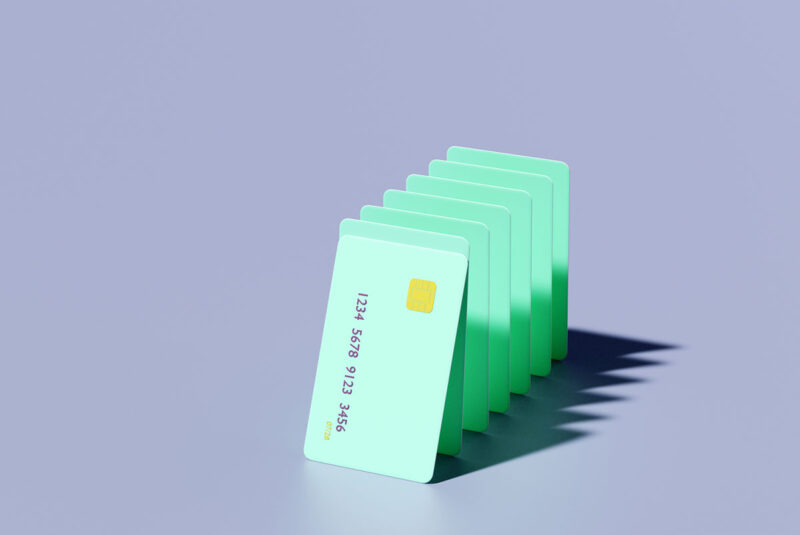Despite what you may have heard, credit cards aren’t evil.
And if you want to build credit — which will help you qualify for a mortgage or a car loan in the future — credit cards are one of the best ways to get started.
But you shouldn’t just apply for cards willy-nilly. Here’s how to strategically (and, fingers crossed, successfully) apply for a credit card.
When you visit MoneyTips, we want you to know that you can trust what’s in front of you. We are an authoritative source of accurate and relevant financial guidance. When MoneyTips content contains a link to partner or sponsor affiliated content, we’ll clearly indicate where that happens. Any opinions, analyses, reviews or recommendations expressed in our content are of the author alone, and have not been reviewed, approved or otherwise endorsed by the advertiser.
We make every effort to provide up-to-date information; however, we do not guarantee the accuracy of the information presented. Consumers should verify terms and conditions with the institution providing the products. Some articles may contain sponsored content, content about affiliated entities or content about clients in the network. While reasonable efforts are made to maintain accurate information, the information is presented without warranty.
At a Glance: How Do You Apply for a Credit Card?
The credit card application process is pretty straightforward. Choose a card, provide the information requested by the issuer, and wait for the issuer’s decision — approval or denial. Just make sure you choose a card that complements your financial situation.
Here’s a simple overview of how it works:
How Do You Apply for a Credit Card?
Knowing where you stand credit-wise should make it easier to pick a card you’ll be approved for.
Find a card that suits your credit scores and provides features that make sense with your spending habits.
If you pre-qualify for a credit card, you generally have a higher chance of approval.
After you’ve chosen a card, you’ll have to provide some personal information, including your name and address, your SSN, and your income. Then, submit the application and wait for the issuer’s decision.
You’ll probably be approved or denied as soon as you submit your application. In some cases, however, you may be asked to provide additional information.
What do you need to apply for a credit card?
Credit card issuers use a variety of information in order to determine whether you qualify for a card. The exact information requested may vary by application. Before you apply for a card, make sure you have the following details on hand:
- Personal information: Name, address, date of birth, employer, occupation, Social Security number (SSN) or Individual Taxpayer Identification Number (ITIN)
- Financial information: Gross annual income, monthly housing payment
- Contact information: Email address, phone number
You’ll often (but not always) need a bank account to apply for a credit card, too.
4 Steps to Apply for a Credit Card
Check your credit scores and reports
It might surprise you to learn you have more than one credit score. The actual number is in the dozens and they will determine the credit cards you qualify for.
Your credit scores are based on factors like whether you make your monthly payments on time during each billing cycle, how long your credit accounts have been open, and how much of your available credit you use.
They’re based on your credit reports from the three major credit bureaus — TransUnion, Equifax, and Experian — and they vary because each bureau has slightly different information about you.
The most common type of score is from FICO. Luckily, you don’t need to pay for access.
While you’re at it, you should also check your credit reports by visiting AnnualCreditReport.com, which offers one free report per bureau per year, or by using issuer-provided services to monitor your credit reports for free. If you see any errors, contact the bureau (and wait until it corrects the mistake before applying for new credit).
Look for a credit card that fits you
There’s no threshold credit score that will get you a credit card, as each card has its own approval requirements.
Once you understand your credit profile, it’s easier to narrow your choices and find the right card for you.
Credit cards are available from a range of banks (Citi, Capital One, Chase, Wells Fargo, etc.) and networks (Visa, American Express, Mastercard, and Discover).
There are also many different types of cards to choose from, including:
- Credit cards for people with limited or no credit history
- Cash back credit cards, which offer cash rewards on eligible purchases
- Travel credit cards, which earn you airline miles or bonus points on eligible purchases
- Business credit cards suitable for small businesses and corporations alike
If you have bad credit or a limited credit history, you might not qualify for a rewards credit card right away.
Instead, you can focus on repairing your credit or building your creditworthiness with one of the credit cards from the “limited or no credit history” category. By using it responsibly, you’ll eventually be able to get whichever rewards card tickles your fancy.
In addition to the perks, you should compare the annual fees of the credit cards you’re considering. If you’re in the market for your first credit card, we recommend getting one without an annual fee. You’ll want to keep the credit card account open for a long time, ideally forever, without having to worry about getting enough value to justify the fee. (Remember: longer credit history = better credit scores.)
You can also take a look at interest rates. While lower interest is better, we recommend completely paying off your credit card’s statement balance by the due date each month. If you do that, you won’t pay any interest all on purchases, rendering the interest rates somewhat inconsequential.
Keep an eye out for “intro APRs,” which are interest rates that last for a certain time after your account opening. You might see, for example, that a card has 0% APR for the first year.
Introductory purchase APRs can be helpful if you need to pay off a big purchase over several months. Or, if you have existing debt, you may want to use an introductory balance transfer APR offer to reduce the amount of interest you’re paying each month. In either case, you should strive to totally pay off your debt before the introductory APR period ends to avoid or reduce the amount of interest you’ll pay.
Check for pre-qualified credit card offers
Now that you have your list of cards that might be a good fit, it’s time to see if you “pre-qualify” for any.
Here’s how this works:
- You’ll enter your information into the credit card issuer’s website.
- A “soft inquiry” into your credit will run.
- If the issuer thinks you’re a good fit for any of its credit cards, it’ll give you a pre-qualified credit card offer. This is not a guarantee, but it does mean you have good odds.
- The next step is to apply for a credit card. This is when a “hard inquiry” will be run. Only then will your application be approved or denied.
Whereas soft inquiries don’t affect your credit, hard inquiries will cause a slight dip. Check for pre-qualified offers first so you’ll only apply for credit cards for which you have a decent chance of being approved. This will result in fewer hard inquiries on your credit reports (and therefore keep your scores as high as possible).
Apply for a credit card
So close! You’ve found the right card, now you need to complete the application.
Here’s how to complete the application process online:
- We recommend turning off your ad blocker before applying, because sometimes they can cause issues when submitting information.
- Click the “apply now” button for the card you want (on the credit issuer’s site).
- You’ll be asked for basic information, like your SSN and address.
- When the form asks for your income, make sure you include everything you earn — even if it’s from multiple jobs or income sources. While it may be tempting to embellish, don’t! It’s illegal.
In many cases, the issuer will instantly approve or deny you when you submit your application. Some of the time, however, it’ll alert you by mail within a few weeks. If the issuer has additional questions about your application, someone may call you, then approve or deny you on the phone.
What If Your Credit Card Application Is Denied?
For most of us — regardless of whether we have “bad” or “good” credit — there will come a day when a credit card application is declined.
The first step you can take is to call up the credit card issuer’s “reconsideration line.” Just like it sounds, this customer service department will take a second look at your credit card application. If you have any negative or unusual entries on your credit reports, this can give you a chance to explain them.
You can also apply for a credit card from your local bank or credit union. If you have a good relationship with the institution, it might be more willing to work with you.
No luck? Don’t start haphazardly applying for new cards, as that will just ding your credit further. The best thing to do is work on building credit.
Here are a few ways to make yourself a more attractive borrower:
- Improve your debt-to-income ratio: If you have a significant amount of debt, use the snowball or avalanche method to pay off as much as you can. And try to increase your income by asking for a raise, working a side job, or switching careers.
- Consider a secured card: Unlike normal credit cards (also called unsecured credit cards), secured credit cards require a security deposit of anywhere from $49 to $10,000, which then serves as your credit limit. Your payments will be reported to the credit bureaus, helping you develop a credit history.
- Look into credit builder loans: These are a special type of installment loan designed to report positive payment activities to credit bureaus and help you build credit.
Just remember: building good credit doesn’t happen overnight. It takes time, diligence, and self-control.
When Should You Apply for a Credit Card?
The best time to apply for a credit card is when it makes the most sense for your financial situation. Here are a few examples of when it might be wise to apply:
- When you turn 18: The earlier you can build your credit scores, the better. U.S. residents generally have to be 18 to apply for credit cards, so if you’re eager to build credit ASAP, you might as well start the moment you’re able.
- When you want to improve your credit scores: Whether you’re trying to build credit from scratch or improve damaged credit, credit cards can help (when used responsibly).
- After you’ve improved your credit scores: There’s nothing wrong with a basic credit card, but if you’ve spent years building great credit, why not apply for something with better rewards and benefits? Premium cards often deliver the most value, but there are plenty of no annual fee cards that are just as worthy of your time.
- When you want to earn rewards or save money on every purchase: A rewards credit card makes it simple to get more value from every purchase you make. Just make sure your statement balance is paid monthly, so you don’t offset your rewards with interest charges.
- When you’re looking to pay off a big purchase over time: If you’d like to avoid interest on a purchase you can’t pay off in one shot, look no further than a 0% APR card. Just make sure the purchase is paid in full before the promotional period ends.
- When you’d like to pay off a current balance at 0% interest: Tired of racking up interest charges on a current credit card debt? Transfer it to another card with a 0% balance transfer APR, and you can likely get a year or more to pay it down interest-free.
Use Your Credit Card Responsibly
When you finally get that piece of plastic in your hands, it might feel like the hard work is over — but in reality, it’s just begun. It’s now time to use your credit card responsibly.
As we mentioned earlier, we recommend only spending what you can pay off in full each month to avoid all interest charges. Then you’ll be able to take advantage of your card’s rewards program and credit-building ability without paying an extra cent!
Even if your new card doesn’t offer a lot of rewards, spending responsibly will allow you to build your credit and, eventually, choose from any of the best credit cards on the market.



